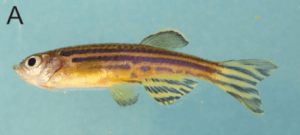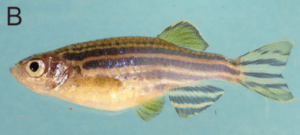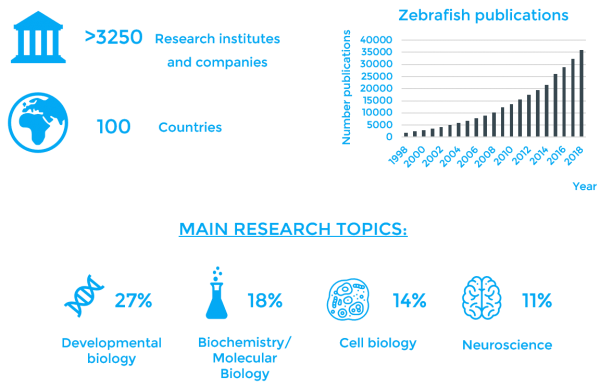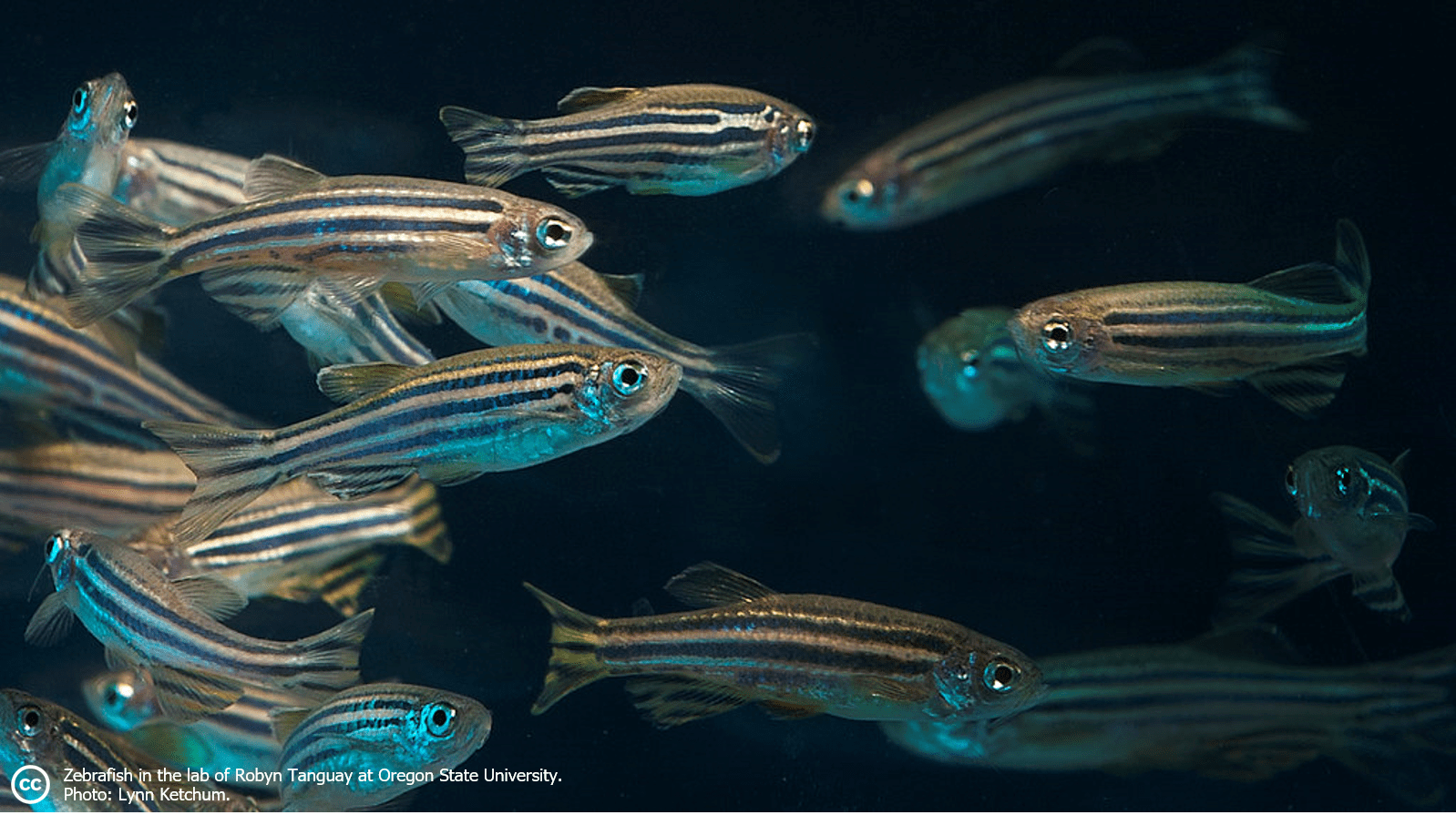As far as research is concerned, all of us are well aware of the use of Mus musculus (mice) or Drosophila melanogaster (fruit flies) as animal models in laboratories. But what about Danio rerio, also known as zebrafish?
Over the past several years, the use of zebrafish as a model in several research areas has increased due to numerous advantages they represent. Particularly their ease of care and breeding, short generation time as well as their rapid and external development in transparent eggs make them an interesting model for molecular genetics, development, embryology and toxicology studies.
In this article, we will cover the main aspects of zebrafish as a model, a bit of the history on the zebrafish model and the current trends:
Zebrafish as a model
Danio rerio is a teleost fish species part of the Cyprinidea family. They are small fresh water fish, found in clear and shallow waters such as streams, canals, ponds and rice paddies in the South of Asia (1-2). As their name suggests, they can be identified by their horizontally stripped bodies. Males and females each have five uniform blue stripes along their sides and can be distinguished from one another as males have a long and golden body, whereas females have a larger abdomen and are lighter in colour (2).


Figure 1: (A) Male zebrafish have a slim golden body and dark blue stripes. (B) Female zebrafish have a large round abdomen, a silver undertone and lighter blue stripes than males. (2)
Zebrafish are known as prolific breeders as females can lay over several hundred oocytes at a time (1-3). After fertilisation, the embryonic cells quickly undergo division and proliferation. It only takes 36 hours for all of the major organs to develop and 96 hours for them to be properly formed. 72 hours post-fertilisation the fish hatch out of the eggs and transition from an embryonic to a larval state. The larval state lasts approximately 4 weeks until the fish reach a size of 11mm. Juvenile fish develop for another couple of months until they reach a size of 17mm and become sexually mature. In captivity, zebrafish can live for 3-4 years, although in the wild they are mostly an annual species (1-2).

Figure 2: Zebrafish lifecycle. Zebrafish transition through an embryonic, larval and juvenile state before becoming sexually mature adults at only 12 weeks post-fertilisation.
Embryonic development has been standardised at 28.5°C, which is the ideal temperature for fast development (2). It is interesting to realise the similarity between the human and zebrafish embryonic development. Although initial cell division follows a meroblastic cleavage in fish rather than holoblastic in humans, segmentation, neurulation and organogenesis undergo the same development pattern. This important conservation between humans and zebrafish make them an excellent model to study complex biological processes (2-3).
History of zebrafish
Charles Creaser was the first to initiate the use of zebrafish in laboratories in the 1930s. It is only 50 years later after an increased rise of interest for zebrafish as an animal model that George Streisinger began a genetic screen of zebrafish using gamma-rays to cause random mutations in the DNA (2).
“The Big Screen” project was launched in 1993 with a goal to describe as many mutant lines as possible, affecting embryonic behaviour and development. By 1996, over 1163 mutant lines were described. The zebrafish genome was fully sequenced and published in 2013, associating genetic bases to phenotypes of previously described mutant lines (2).

The zebrafish genome is made up of 26’000 genes, over 1.4 million base pairs and 25 pairs of chromosomes (2).
In 1994, researchers set up an online database for zebrafish information, nowadays known as the Zebrafish Information Network (ZFIN). All of the genomic and genetic data of Danio rerio as an organism model is gathered on one platform, allowing worldwide researchers to easily access the resources they need for the use of zebrafish in their laboratory (4).
Current research
About 70% of human disease genes have a functional equivalent in zebrafish, making zebrafish very similar to humans and excellent models for research (5). In addition, as animal welfare concerns increase, the use of fish in laboratories is becoming very popular, as fish are lower in the evolutionary scale than mammals and their use is less regulated. As some studies suggest that fish can perceive pain and fear and can modify their behaviour to nociceptive stimuli, the “three R’s principle” must still be applied (6).

Figure 3: Research done in zebrafish. There are more than 3250 institutions working with zebrafish around the world, in more than 100 countries (11). The number of publications using zebrafish has increased over the years (4) being the main topics: developmental biology, biochemistry, cell biology and neuroscience (12).
Although adult fish are animals sensitive to fear and pain, fish embryos and larva are not considered as so until they are capable of independent feeding (6-7). As embryonic development occurs in a transparent egg, fish embryos are great models for development and toxicology studies. Zebrafish are indeed very popular in preclinical drug screening experiments as it is easy to evaluate drug effects on the developing embryos and larva. Additionally, bioassays on zebrafish are cheaper and faster than on mice and the teratogenic effects, toxic response and LC50 (lethal concentration) in zebrafish are similar to results achieved in mice (7).
As many mutant strains are available for highly conserved genes, zebrafish can be used to study many physiological disorders such as cardiovascular and neurological defects or metabolic syndromes. For several years they have been a model for cardiovascular research, to study cardiovascular development and disease (8) as well as neurobiological mechanisms and diseases such as Alzheimer’s (1, 9-10).
According to a survey performed in 2016, over 3250 institutes in 100 different countries work with zebrafish as an animal model in their laboratories (11). As ethical concerns rise regarding animal experimentation, these numbers are set to increase over the next years. In addition to best welfare practices, the numerous advantages related to zebrafish mentioned through this short article make them interesting substitutes to rodents and other mammals used in laboratories and are definitely worth considering as an animal model for your next study.
References
(1) Kalueff AV, Stewart AM, Gerlai R. Zebrafish as an emerging model for studying complex brain disorders. Trends Pharmacol Sci. (2014). doi:10.1016/j.tips.2013.12.002
(2) Meyers, J. R. Zebrafish: Development of a vertebrate model organism. Current Protocols Essential Laboratory Techniques. (2018). doi: 10.1002/cpet.19
(3) Parng C, Seng WL, Semino C, McGrath P. Zebrafish: a preclinical model for drug screening. Assay Drug Dev Technol. (2002). doi:10.1089/154065802761001293
(4) Ruzicka L, et al. The Zebrafish Information Network: new support for non-coding genes, richer Gene Ontology annotations and the Alliance of Genome Resources. Nucleic Acids Res. (2019).
(5) Santoriello C, Zon LI. Hooked! Modeling human disease in zebrafish. J Clin Invest. (2012). doi:10.1172/JCI60434
(6) Schaeck M, Van den Broeck W, Hermans K, Decostere A. Fish as research tools: alternatives to in vivo experiments. Altern Lab Anim. (2013). doi:10.1177/026119291304100305
(7) Kari G, Rodeck U, Dicker AP. Zebrafish: an emerging model system for human disease and drug discovery. Clin Pharmacol Ther. (2007). doi:10.1038/sj.clpt.6100223
(8) Bakkers J. Zebrafish as a model to study cardiac development and human cardiac disease. Cardiovasc Res. (2011). doi:10.1093/cvr/cvr098
(9) Adams MM, Kafaligonul H. Zebrafish-A Model Organism for Studying the Neurobiological Mechanisms Underlying Cognitive Brain Aging and Use of Potential Interventions. Front Cell Dev Biol. (2018). doi:10.3389/fcell.2018.00135
(10) Newman M, Ebrahimie E, Lardelli M. Using the zebrafish model for Alzheimer’s disease research. Front Genet. (2014). doi:10.3389/fgene.2014.00189
(11) Lidster K, Readman GD, Prescott MJ, Owen SF. International survey on the use and welfare of zebrafish Danio rerio in research. J Fish Biol. (2017). doi:10.1111/jfb.13278
(12) Kinth P, Mahesh G, Panwar Y. Mapping of Zebrafish Research: A Global Outlook . ZEBRAFISH. Mary Ann Liebert, Inc.. Volume 10, Number 4 (2013). doi: 0.1089/zeb.2012.0854



